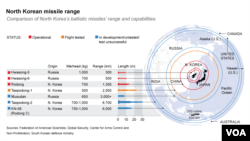North Korea is following a familiar pattern of defiance in response to the tough new international sanctions imposed on the country for conducting its fourth nuclear test and launching another long-range rocket.
Pyongyang launched its latest provocation on Friday morning, firing two medium range ballistic missiles from its east coast and sending them about 800 km into the sea. One of the Rodong missiles, which have the potential range to reach Japan, appeared to have exploded mid-flight.
North Korea did not declare a no-sail zone prior to the launch, even though it is required under international conventions to warn ships that may be in the area.
Neither missile was assessed to be a threat to the United States or its regional allies, according to the U.S. Defense Department.
The launches, which are a violation of multiple U.N. Security Council resolutions prohibiting the North from developing nuclear and ballistic missile capabilities, occurred one day after the United States announced further unilateral sanctions against the Kim Jong Un government.
History repeats
The missile launches are the latest retaliatory acts North Korea has made since the United Nations imposed tough new sanctions on March 2. They mirror the North’s response to the last round of U.N. sanctions imposed in 2013 after its third nuclear test.
Almost immediately after the U.N. sanctions were announced this month, North Korea fired several short-range projectiles into the East Sea, also known as the Sea of Japan.
And Friday, the North launched two medium range missiles into the sea.
North Korea launched a series of short-range missiles over one weekend in May 2013.
Nuclear advancement
This month the country’s Supreme Leader Kim Jong Un ordered further nuclear and missile tests. State media KCNA published photographs of Kim inspecting sites where miniaturized nuclear warheads and advanced long-range ballistic missile technologies were supposedly being developed.
However, North Korea has yet to demonstrate this type of capability and many analysts express skepticism that the country’s nuclear program has reached that advanced development stage.
In 2013 Kim ordered the country's atomic energy department to restart the uranium enrichment plant and the five-megawatt reactor at its Yongbyon nuclear complex. The North had closed the facility in 2007 under an agreement reached at six-party talks with the United States, China, Russia, Japan and South Korea.
Korean-American's public sentencing
This week the North Korean Supreme Court sentenced an American college student to 15 years of hard labor for crimes against the state.
The student, Otto Warmbier from the University of Virginia, was visiting Pyongyang with a group of tourists when he was apprehended for attempting to take down a banner with a political slogan.
In 2013 North Korea sentenced Korean-American tour operator Kenneth Bae to 15 years of hard labor after being convicted of hostile acts against the reclusive state.
Bae and Matthew Todd Miller, another American being held by North Korea, were released in 2014 after U.S. National Intelligence Director James Clapper visited Pyongyang.
The continued repetition of provocation and crisis have led many, especially in South Korea, to downplay the reality of North Korea’s nuclear advancement and growing threat to regional peace and stability, said analyst Ahn Chan-il, of the World Institute for North Korean Studies in Seoul.
“At this point, it is regrettable that we have become dull on North Korea’s military provocation which continues to upgrade,” he said.
While the North’s aggressive responses follow the same defiant pattern, advocates for sanctions say there is cause to believe that the new U.S. measures, in addition to the U.N. sanctions imposed this year, will deliver a different outcome.
“I think it is good to see that the Obama administration is imposing actual sanctions and pressure while it had had a naïve policy in the past against North Korea,” said Ahn.
International condemnation
As international sanctions increase economic pressure on Pyongyang, Washington, Seoul and Tokyo have increased their defense readiness postures. U.S. and South Korean forces are currently conducting joint annual military exercises.
The U.S. allies condemned the North’s latest violation of U.N. Security Council resolutions, which prohibit it from developing nuclear weapons and ballistic missile capability. “North Korea's missile launch is a frontal attack against the U.N. Security Council Resolution and a significant threat to peace and stability in the international society," said South Korean Defense Ministry spokesman, Moon Sang-Gyun.
Japanese Prime Minister Shinzo Abe called the launch “extremely problematic” and called on the North to cease such actions.
And U.S. Secretary of State John Kerry issued a statement calling on North Korea to “focus instead on taking concrete steps toward fulfilling its international commitments and obligations.”
Youmi Kim in Seoul contributed to this report.










